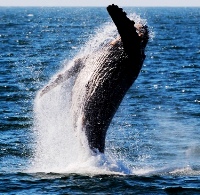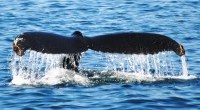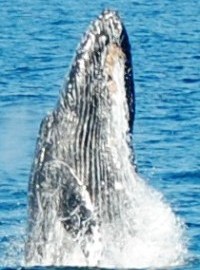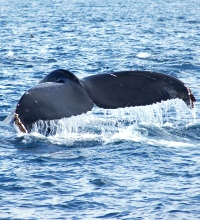(949) 675-0551 |
 |
DESCRIPTION: The humpback whale is a baleen whale and a member of the rorqual family much like the blue whale, fin whale, and minke whale. These whales have two blowholes, fins on their backs and ventral pleats that go from their lower jaw to their stomachs. They are one of larger whales ranging in size from 40-50 feet and weighing 25-40 tons. The four-chambered heart of the average humpback whale weighs about 430 pounds. The females are slightly larger due to the need to give birth and care for their young. The head, fins, and fluke of a humpback whale have a bumpy texture to them and may be covered with barnacles. Their bodies are rounded and are black on the upper (dorsal) side and mottled black and white on the under (ventral) side. The coloring and shape of a humpback whale's dorsal fin and fluke are completely unique to each whale. The flippers are between ¼ and 1/3 of it body length. The name Megaptera means "giant wings". |
 |
RANGE/HABITAT: Humpback Whales are found in every ocean except the polar seas and prefer shallow waters. They travel from colder climates, where they eat, to warmer climates where they give birth to their young. Their migration can be thousands of miles each year. They are the longest traveling mammal. There is one group of whales that does not migrate. They remain in the Arabian Sea year round. |
 |
BEHAVIOR: During the summer, the humpback whale eats krill and small fish by ingesting large amounts of food and water through its baleen plates. The water is expelled through the plates and the food is left behind. These are the only whales that use a technique called bubble net feeding. A group of whales swim in a circle while blowing bubbles. They get closer together while other whales scar the bait closer with slapping or vocalization. Once the bait is in a tight enough ball, the whales propel through it with their mouths open. During the winter, the whales move to warmer climates for mating and giving birth. At this time, they fast and live off of fat stores. Humpback whales are extremely acrobatic. They are known for breaching or throwing their whole bodies out of the water. They will also slap their fin or fluke on the water or swim on their backs with their fins in the air. The most interesting behavior of the humpback whale comes from the males and their "whale song". These whales sing long complex songs that can last 20-30 minutes and will be repeated continuously for hours at a time. The songs change gradually each yeah. Each section of whales will sing its own song. Those located in the North American Pacific sing the same song but it is different from the song the North American Atlantic whales all sing. Some scientists believe that this song is used for mating. |
| MATING/BREEDING: Females reach sexual maturity at age 5 and usually breed every 2-3 years with an 11.5 month gestation. Males reach sexual maturity at age 7. The lifespan of a humpback whale is 45-100 years. Groups of two to twenty males will follow a single female and show off to establish dominance. Newborn calves are 10-15 feet long and 1-1.5 tons. They nurse on their mother's milk, which is 45% - 60% fat content, for about 6 months after which they begin to introduce solid food into their diets. They are usually weaned off the milk by the time they are one. STATUS: Like most large whales, humpback whales were victims of whaling. They are slow swimmers and remain in shallow water for feeding, mating, and birthing so they are easy targets. In 1966, the International Whaling Commission (IWC) granted them worldwide protection. Their numbers are steadily growing from a vulnerable state to one of almost pre-whaling population. |
|
 |
|
For Reservations Call: |
||
(949) 675-0551 |
||
Newport Beach Whale Watching 309 Palm St. #A - Newport Beach CA. 92661 |
||
Copyright © 2001 Newport Landing
Whale Watching |
Whale Watching | Whale Watching Dana Point Visitors | Whale Watching Long Beach Visitors | Whale Watching Los Angeles Visitors
Whale Watching San Diego Visitors | Huntington Beach Whale Watching | Whale Watching Laguna Beach | Catalina Island Whale Watching